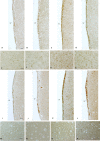Dietary curcumin supplementation attenuates 1-methyl-4-phenyl-1,2,3,6-tetrahydropyridine (MPTP) neurotoxicity in C57BL mice
- PMID: 26538809
- PMCID: PMC4604129
- DOI: 10.1293/tox.2015-0020
Dietary curcumin supplementation attenuates 1-methyl-4-phenyl-1,2,3,6-tetrahydropyridine (MPTP) neurotoxicity in C57BL mice
Erratum in
-
Errata (Printer's correction).J Toxicol Pathol. 2016 Jan;29(1):74. Epub 2016 Feb 17. J Toxicol Pathol. 2016. PMID: 26989306 Free PMC article.
Abstract
Studies in vivo and in vitro suggest that curcumin is a neuroprotective agent. Experiments were conducted to determine whether dietary supplementation with curcumin has neuroprotective effects in a mouse model of Parkinson's disease (PD). Treatment with 1-methyl-4-phenyl-1,2,3,6-tetrahydropyridine (MPTP) significantly induced the loss of dopaminergic cells in the substantia nigra and deletion of dopamine in the striatum, which was attenuated by long-term (7 weeks) dietary supplementation with curcumin at a concentration of 0.5% or 2.0% (w/w). Although curcumin did not prevent the MPTP-induced apoptosis of neuroblasts in the subventricular zone (SVZ), it promoted the regeneration of neuroblasts in the anterior part of the SVZ (SVZa) at 3 days after MPTP treatment. Furthermore, curcumin enhanced the MPTP-induced activation of microglia and astrocytes in the striatum and increased the expression of glial cell line-derived neurotrophic factor (GDNF) and transforming growth factor-β1 (TGFβ1) in the striatum and SVZ. GDNF and TGFβ1 are thought to play an important role in protecting neurons from injury in the central and peripheral nervous systems. These results suggest that long-term administration of curcumin blocks the neurotoxicity of MPTP in the nigrostriatal dopaminergic system of the mouse and that the neuroprotective effect might be correlated with the increased expression of GDNF and TGFβ1. Curcumin may be effective in preventing or slowing the progression of PD.
Keywords: MPTP; astrocyte; curcumin; dopamine; microglia; neuroprotective.
Figures







References
-
- Langston JW, Langston EB, and Irwin I. MPTP-induced parkinsonism in human and non-human primates—clinical and experimental aspects. Acta Neurol Scand Suppl. 100: 49–54. 1984. - PubMed
-
- Chiueh CC, Markey SP, Burns RS, Johannessen JN, Jacobowitz DM, and Kopin IJ. Neurochemical and behavioral effects of 1-methyl-4-phenyl-1,2,3,6- tetrahydropyridine (MPTP) in rat, guinea pig, and monkey. Psychopharmacol Bull. 20: 548–553. 1984. - PubMed
-
- Heikkila RE, Cabbat FS, Manzino L, and Duvoisin RC. Effects of 1-methyl-4-phenyl-1,2,5,6-tetrahydropyridine on neostriatal dopamine in mice. Neuropharmacology. 23: 711–713. 1984. - PubMed
-
- Francis JW, Von Visger J, Markelonis GJ, and Oh TH. Neuroglial responses to the dopaminergic neurotoxicant 1-methyl-4-phenyl-1,2,3,6-tetrahydropyridine in mouse striatum. Neurotoxicol Teratol. 17: 7–12. 1995. - PubMed
LinkOut - more resources
Full Text Sources
Other Literature Sources
